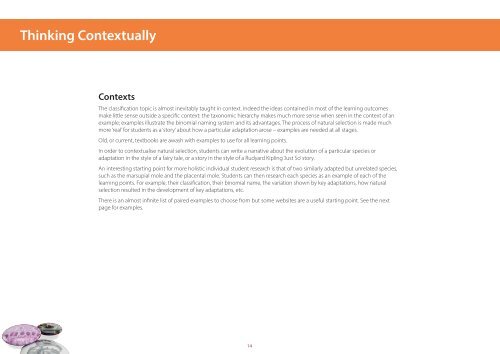BIOLOGY A
234241-classification-and-evolution-delivery-guide
234241-classification-and-evolution-delivery-guide
Create successful ePaper yourself
Turn your PDF publications into a flip-book with our unique Google optimized e-Paper software.
Thinking Contextually<br />
Contexts<br />
The classification topic is almost inevitably taught in context. Indeed the ideas contained in most of the learning outcomes<br />
make little sense outside a specific context: the taxonomic hierarchy makes much more sense when seen in the context of an<br />
example; examples illustrate the binomial naming system and its advantages. The process of natural selection is made much<br />
more ‘real’ for students as a ‘story’ about how a particular adaptation arose – examples are needed at all stages.<br />
Old, or current, textbooks are awash with examples to use for all learning points.<br />
In order to contextualise natural selection, students can write a narrative about the evolution of a particular species or<br />
adaptation in the style of a fairy tale, or a story in the style of a Rudyard Kipling ‘Just So’ story.<br />
An interesting starting point for more holistic individual student research is that of two similarly adapted but unrelated species,<br />
such as the marsupial mole and the placental mole. Students can then research each species as an example of each of the<br />
learning points. For example, their classification, their binomial name, the variation shown by key adaptations, how natural<br />
selection resulted in the development of key adaptations, etc.<br />
There is an almost infinite list of paired examples to choose from but some websites are a useful starting point. See the next<br />
page for examples.<br />
14


